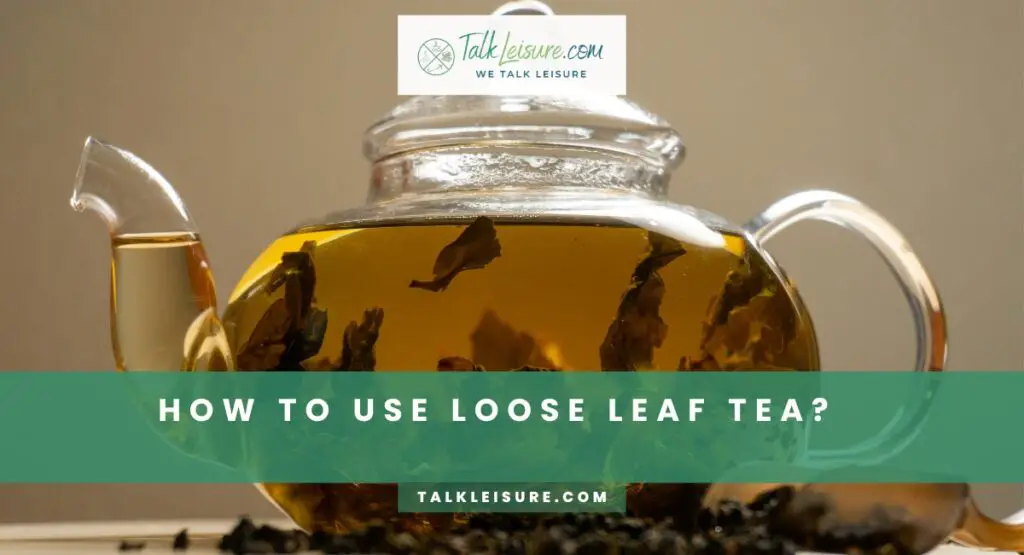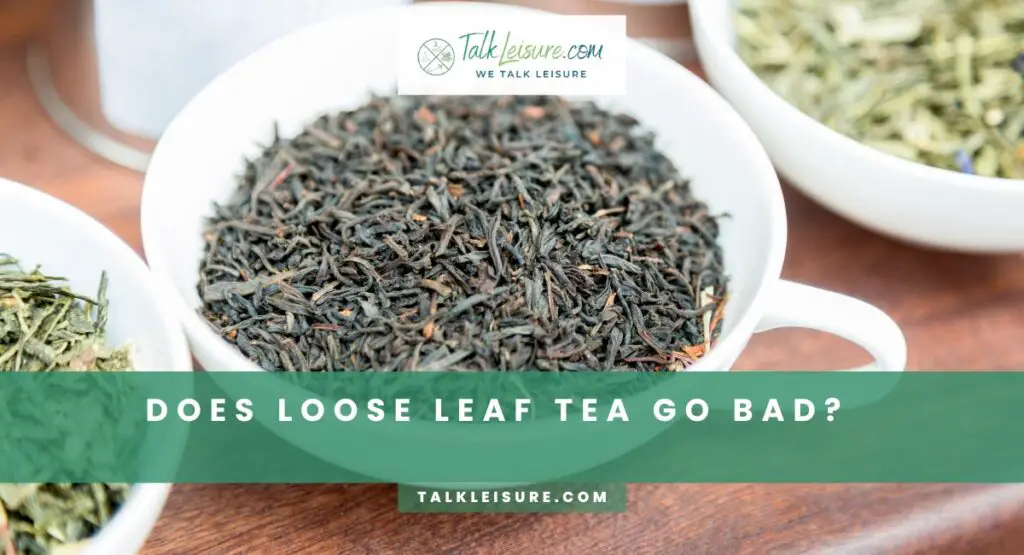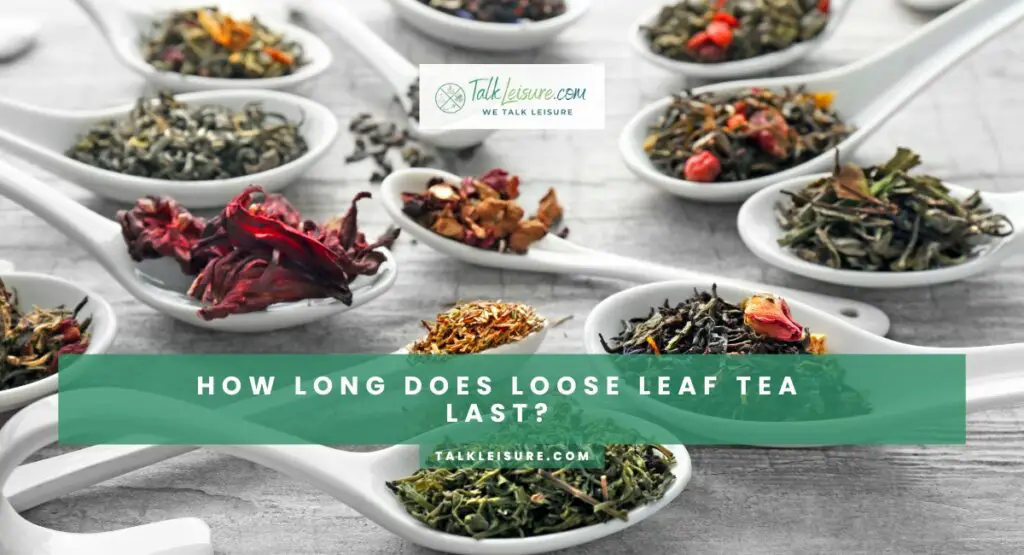Welcome to the delightful world of loose-leaf tea!
Loose-leaf tea is your perfect companion if you’re tired of the same old tea bags and craving a more authentic and flavorful experience.
Using loose-leaf tea is surprisingly easy, and in this guide, we’ll show you the simple steps to brew the perfect cup.
To use loose-leaf tea, measure the desired amount, typically one teaspoon per cup. Place the tea in an infuser or directly in a teapot. Add hot water and steep for the recommended time. Strain and enjoy.
First, say goodbye to pre-portioned tea bags and embrace the loose leaves’ natural beauty and aroma.
Don’t worry; no fancy equipment is needed. You only need your favorite loose-leaf tea, a tea infuser, hot water, and a mug.
So, let’s embark on this tea adventure together and unlock the full potential of loose-leaf tea to savor each sip like never before!
Loose Leaf Tea Vs. Bagged Tea
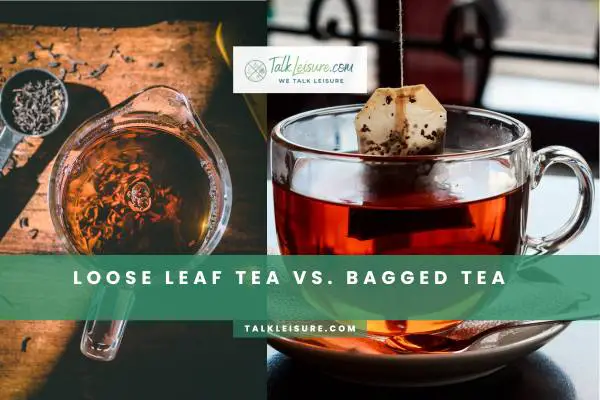
Loose Leaf and Bagged Tea offer delightful tea experiences, but they differ.
Like a beautiful dance of flavors, loose-leaf tea unfurls its full potential.
Its larger, unconfined leaves allow for more natural steeping and better infusion, resulting in a richer taste.
Plus, it’s environmentally friendly since it reduces waste with reusable infusers.
On the other hand, bagged tea offers convenience with its pre-measured, ready-to-use bags, perfect for a quick cup on busy days.
However, it might sacrifice some flavor as the confined tea leaves have less room to expand. So, if you savor a tea adventure, go for loose leaf.
But for a hassle-free sip, bagged tea is your ideal companion.
Here’s a simple comparison table for Loose Leaf Tea vs. Bagged Tea:
| Aspect | Loose Leaf Tea | Bagged Tea |
|---|---|---|
| Flavor | Rich and Full-bodied | Slightly Milder |
| Brewing Experience | Engaging and Enjoyable | Quick and Convenient |
| Infusion | Better Infusion due to larger leaves | Limited Infusion in small bags |
| Environmental Impact | Environmentally Friendly (less waste) | More Waste (disposable bags) |
| Customization | Adjustable quantity and blend | Pre-measured and standardized |
| Price | Sometimes more expensive | Often more affordable |
What Is Loose Leaf Tea?
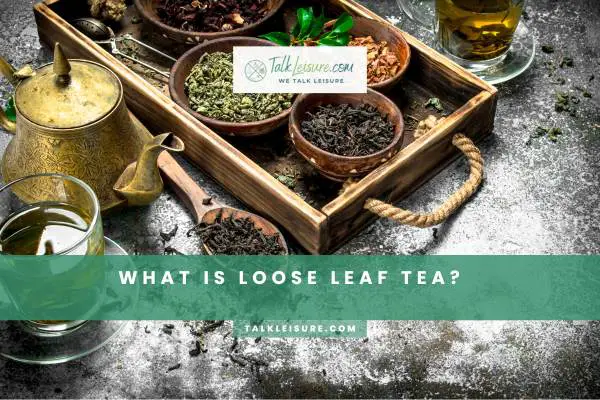
Loose-leaf tea is a delightful and natural way to enjoy comforting tea.
Loose-leaf tea consists of whole tea leaves or larger pieces not enclosed in tea bags. It offers a fresher flavor and aroma compared to pre-packaged tea bags.
Unlike traditional tea bags, loose-leaf tea consists of whole tea leaves, herbs, and spices, allowing for a fresher and more flavorful experience.
The leaves are not confined to a small bag, giving them space to unfurl and release their full aroma and taste.
You’ll need an infuser or a teapot with a built-in strainer to brew loose-leaf tea.
Just scoop the desired amount of tea leaves into the infuser, pour hot water over them, and let it steep for a few minutes.
As you sip your tea, you’ll appreciate the pure, unadulterated essence of the leaves, making each cup truly blissful.
A Beginner’s Guide To Loose Leaf Tea
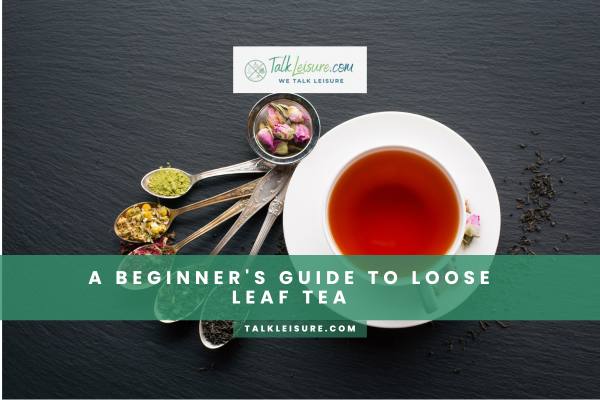
Loose-leaf tea offers premium flavor and quality compared to tea bags.
Start by selecting a tea type: black, green, white, oolong, or herbal. Measure one teaspoon of leaves per cup, adjusting to taste.
Boil water and let it cool slightly. Infuse leaves for the recommended time (2-5 minutes). Use a strainer to pour the tea into your cup.
Experiment with steeping times and water temperatures.
Embrace the variety of flavors and health benefits. Enjoy the journey of discovering your favorite loose-leaf teas.
Types of Loose Leaf Tea
Loose-leaf tea comes in various flavors, aromas, and colors, making it a delightful choice for enthusiasts. Here are some common types of loose-leaf tea you might encounter:
Black Tea: Known for its bold and robust flavor, black tea is fully oxidized, resulting in a dark color. It pairs well with milk and sugar and is perfect for starting mornings or as an afternoon pick-me-up.
Green Tea: Green tea is unoxidized, retaining its vibrant green color and natural antioxidants. It offers a fresh, grassy flavor with slight variations depending on the region of origin. Green tea is known for its potential health benefits.
White Tea: Among the least processed types, white tea consists of young tea leaves and buds. It has a delicate, subtle flavor and a pale color. White tea is perfect for those who prefer a milder tea experience.
Oolong Tea: Partially oxidized, oolong tea falls between black and green teas in flavor and color. It often has a fruity or floral taste; some varieties can be complex and nuanced.
Herbal Tea: Herbal teas are not made from the Camellia sinensis plant but from various herbs, flowers, spices, and fruits. Examples include chamomile, peppermint, hibiscus, and rooibos. Herbal teas offer a diverse range of flavors and are caffeine-free.
How Do I Choose Which Tea To Drink?
Selecting the right tea for you is a matter of personal preference and experimentation. Here are some tips to help you decide:
Taste Preferences: Consider whether you prefer bold and robust flavors (like black tea) or lighter and more delicate notes (like green or white tea).
Caffeine Sensitivity: If you’re sensitive to caffeine, you might opt for herbal teas or caffeine-free blends.
Health Benefits: Different teas offer various health benefits due to their unique properties. For example, green tea is often praised for its antioxidants, while herbal teas can have soothing effects.
Season and Occasion: Some teas are more suited for specific seasons or occasions. For example, iced tea might be refreshing in the summer, while a comforting chai blend might be ideal for chilly evenings.
Experimentation: Don’t be afraid to try new teas and explore different flavors. Tea tasting can be a delightful journey of discovery.
How To Brew Loose Leaf Tea
Brewing loose-leaf tea is an art that requires a few simple steps to achieve the best flavor:
Measure the Tea: Use a teaspoon or a scale to measure the desired tea leaves. As a general guideline, use one teaspoon per 8 ounces of water.
Heat the Water: Boil fresh, filtered water and let it cool slightly to the appropriate temperature for brewing tea. Green teas usually require cooler water (around 170-185°F or 75-85°C), while black teas and herbal teas can handle boiling water (212°F or 100°C).
Preheat the Teapot or Infuser: Pour a small amount of hot water into the teapot or infuser to preheat it. Discard this water.
Add the Tea and Water: Place the measured tea leaves into the teapot or infuser. Pour the hot water over the tea leaves, fully submerging them.
Steep the Tea: The steeping time varies depending on the type of tea and your preference for strength. Generally, black teas steep for 3-5 minutes, green teas for 2-3 minutes, white teas for 2-4 minutes, and herbal teas for 5-7 minutes. Follow the recommended steeping times for the best results.
Strain and Serve: Once the tea has steeped, remove the tea leaves by straining the liquid into your teacup. You can now enjoy your freshly brewed loose-leaf tea.
How To Store Loose Leaf Tea
Proper storage is crucial to maintain the freshness and flavor of your loose-leaf tea:
Airtight Containers: Transfer your loose-leaf tea to airtight glass, ceramic, or metal containers. These containers protect the tea from air, light, and moisture exposure.
Avoid Heat and Sunlight: Store your tea containers in a cool, dark place away from heat sources and direct sunlight. Avoid storing them near the stove or other appliances that emit heat.
Keep Away From Odors: Loose-leaf tea can absorb strong odors from its surroundings, so store it away from spices, coffee, or other strong-smelling items.
Limited Air Exposure: Avoid when the tea container is open to reduce air exposure. Only open the container when you need to measure the tea for brewing.
Buy in Small Quantities: If possible, purchase loose-leaf tea in smaller quantities to ensure you consume it while it’s fresh.
Following these guidelines lets you enjoy loose-leaf tea’s rich and diverse world.
Experiment with different teas, brewing techniques, and infusions to find your perfect cup of tea.
What To Do With Loose Leaf Tea?
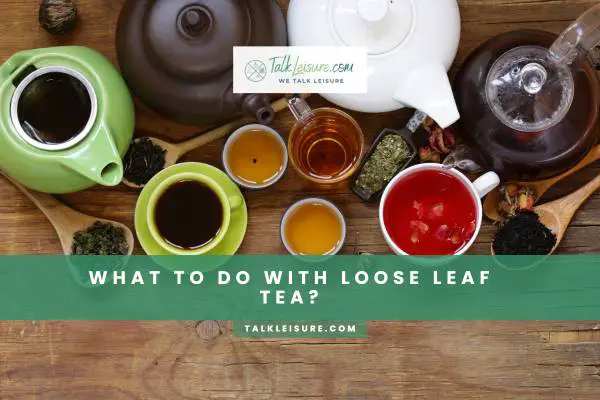
When you have loose leaf tea on hand, several delightful ways exist to make the most of it. Firstly,
And brewing loose-leaf tea allows you to experience its full flavor potential.
Grab a tea infuser or strainer to steep the leaves in hot water for a few minutes, depending on your tea type.
You can explore various tea types like black, green, oolong, or herbal, each offering distinct tastes and aromas.
If you prefer a stronger brew, increase the steeping time slightly.
Consider using a teapot or a tea press to serve multiple cups for an extra touch of elegance.
Moreover, loose leaf tea can be incorporated into recipes like iced tea, lattes, and even tea-infused cocktails.
Embrace the versatility of loose-leaf tea and savor every sip, knowing you are experiencing a world of tea beyond the ordinary tea bag.
Knowing more about loose-leaf tea is important for the best experience.
What Are The Benefits Of Loose Leaf Tea?

Loose-leaf tea offers a range of wonderful benefits that can enhance your tea-drinking experience.
First, loose-leaf tea provides a superior taste and aroma to tea bags, as it retains more essential oils and natural flavors.
It’s also more customizable, allowing you to adjust the strength and flavor to your preference.
Moreover, loose-leaf tea is environmentally friendly, generating less waste than tea bags, which often contain plastic. Brewing loose-leaf tea is a delightful ritual that can be soothing and help reduce stress.
Furthermore, loose-leaf tea contains more antioxidants, which support overall health and boost the immune system.
You can explore diverse flavors and health benefits with various loose-leaf teas.
Plus, it’s often more cost-effective in the long run, as you can re-steep loose-leaf tea multiple times without losing its quality.
So, why not dive into loose-leaf tea and enjoy its numerous advantages?
How To Make Loose Leaf Tea?

Making loose-leaf tea is a simple and enjoyable process. Follow these steps to make a delicious cup of loose-leaf tea:
Boil water: Start by boiling fresh, filtered water. Bring it to a rolling boil and cool slightly to the desired temperature.
Measure the tea: Use a teaspoon or an infuser to measure the loose-leaf tea. Generally, one teaspoon of tea per 8 ounces of water is a good rule of thumb.
Preheat the teapot: Pour a small amount of hot water into your teapot or cup and swirl it around to warm the vessel. This helps maintain the tea’s temperature during steeping.
Add the tea leaves: Put the measured tea leaves into the infuser or the preheated teapot.
Steep the tea: Pour the hot water over the tea leaves and let it steep for the appropriate time. This varies depending on the type of tea – black tea generally takes 3-5 minutes, green tea 2-3 minutes, white tea 4-6 minutes, and herbal tea 5-7 minutes.
Remove the leaves: Once the steeping time is up, remove the tea leaves or infuser to prevent overstepping.
Enjoy your tea: Pour the freshly brewed tea into your cup, and you’re ready to enjoy a delightful cup of loose-leaf tea.
A Tea Preparation Chart
To prepare boil water to the appropriate temperature for the tea type (e.g., black, green, herbal).
Place one tablespoon of loose-leaf tea per cup in a teapot or infuser.
Pour hot water over the leaves and steep for the recommended time (2-5 mins).
Strain or remove the leaves, and enjoy. Adjust steeping time and tea amount to taste preference.
| Tea Type | Amount of Leaves | Water Temperature | Steep Time |
|---|---|---|---|
| Green Tea | 1 tsp per cup | 175°F (80°C) | 2-3 minutes |
| Black Tea | 1 tsp per cup | 212°F (100°C) | 3-5 minutes |
| White Tea | 1.5 tsp per cup | 175°F (80°C) | 2-3 minutes |
| Oolong Tea | 1.5 tsp per cup | 185-205°F (85-96°C) | 3-4 minutes |
| Herbal Tea | 1 tsp per cup | 212°F (100°C) | 5-7 minutes |
| Pu-erh Tea | 1 tsp per cup | 212°F (100°C) | 4-6 minutes |
How To Brew Loose Leaf Tea?
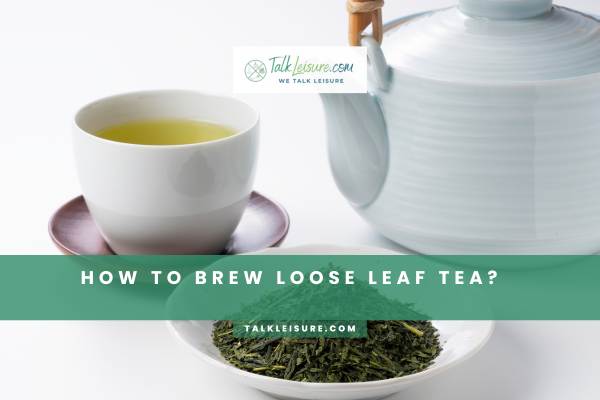
To brew loose-leaf tea, start by heating water in a kettle until it reaches the desired temperature – usually between 175°F to 212°F (80°C to 100°C), depending on the type of tea.
While the water heats up, take a tea infuser or strainer and add the appropriate amount of loose tea leaves, usually one teaspoon per cup.
Once the water is ready, pour it into a teapot or mug over the tea leaves. Let the tea steep for the recommended time – typically 2 to 5 minutes for most teas, but it can vary.
After steeping, remove the infuser or strain the tea to separate the leaves from the brewed liquid.
Finally, relax, and enjoy your delicious cup of loose-leaf tea!
How To Brew Loose Leaf Tea Without An Infuser?
Brewing loose-leaf tea without an infuser is easy and can still result in a delicious cup of tea.
You’ll need a teapot or mug with a built-in strainer. Start by heating water to the appropriate temperature for your tea type (e.g., black, green, herbal).
Add the loose tea leaves directly to the teapot or mug, about one teaspoon per cup of water.
Pour the hot water over the leaves and let it steep for the recommended time, usually 2-5 minutes.
Once it’s steeped, carefully pour the tea into your cup, leaving the leaves behind.
You can strain the tea through a fine sieve or use a tea ball. Enjoy your flavorful cup of loose-leaf tea!
How To Brew Loose Leaf Tea With An Infuser?
Brewing loose-leaf tea with an infuser is a convenient and popular method that allows you to steep and remove the tea leaves easily.
Choose a quality tea infuser that fits your teapot or mug.
Heat water to the appropriate temperature for your tea type. Place the desired amount of loose tea leaves inside the infuser, about one teaspoon per cup.
Insert the infuser into the teapot or mug and pour the hot water over it.
Allow the tea to steep for the recommended time, typically 2-5 minutes.
Once ready, remove the infuser, which will have trapped the leaves, and set it aside.
Now, your perfectly brewed loose-leaf tea is ready to be savored!
Final Thoughts
In conclusion, incorporating loose-leaf tea into your daily routine is a delightful and rewarding experience that elevates your tea-drinking journey to new heights.
By following the steps outlined above, you can ensure that each cup is a transcendent infusion of flavor and aroma, surpassing the limitations of pre-packaged tea bags.
The art of loose-leaf tea brewing empowers you to customize your beverage perfectly, allowing you to experiment with different tea varieties, brewing times, and temperatures.
This ancient tradition grants you a more authentic and nuanced taste and promotes sustainability and eco-friendliness by minimizing waste.
As you embark on this tea adventure, don’t hesitate to explore many teas worldwide, each with its unique story and character.
FAQ
How Do You Make Tea With Loose Tea?
To make tea with loose tea, start by boiling water.
Measure the desired amount of loose tea leaves (about one teaspoon per cup).
Place the leaves in a tea infuser or a teapot. Pour the hot water over the leaves and steep for 2-5 minutes, depending on the tea type and strength preference.
Remove the leaves and enjoy your flavorful cup of tea.
How Do You Drink Tea With Loose Leaves?
To enjoy tea with loose leaves, boil water and let it cool a bit.
Add the desired amount of loose tea leaves with a teapot or infuser. Pour the hot water over the leaves and allow them to steep for the recommended time.
When the steeping is complete, use a strainer or remove the infuser to separate the leaves from the tea.
Now, pour the freshly brewed tea into your cup and savor the aromatic flavors and rich taste of loose-leaf tea. Enjoy your delightful tea-drinking experience!
Are You Supposed To Drink Loose Leaf Tea?
No, you are not supposed to drink loose-leaf tea. It is a matter of personal preference. Some people prefer loose-leaf tea for its flavor and aroma, while others may prefer the convenience of tea bags. Both types of tea can offer a delightful experience, and the choice depends on your taste and brewing preferences.
Enjoy your tea!

